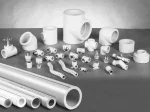PPR (polypropylene random copolymer) fittings are components used to connect, redirect, and control the flow of water in plumbing systems. They are designed to provide a strong, permanent seal that is capable of withstanding years of use and pressure fluctuations. They are also easy to install and can be installed quickly compared to traditional methods such as threading and cementing. These advantages make ppr pipe fittings a highly popular choice for modern construction projects.
Ppr pipes can be joined to each other using a variety of techniques, but fusion welding is the most common method due to its economy and durability. This is a type of heat-fusion welding that melts the ends of two pipes together, forming a solid bond that will not weaken or crack over time. This type of joining is performed either end to end (butt fusion) or into the fitting hub.
Unlike mechanical slip fit fittings, fusion-welded joints are made by melting the end of one pipe into the socket of another pipe and heating it until it completely melts through the wall of the other pipe. This process can take a while, so it is important to read the manufacturer’s manual and follow the directions carefully to ensure a high-quality join.
Some of the most common types of ppr fittings include couplings, elbows, and caps. Couplings are used to connect straight sections of pipe together and can be attached to either male or female sockets. They are available in a variety of sizes and are easy to install. When installing a PPR coupling, be sure to align the ends correctly and wait for the connection to cool before applying pressure.
An elbow is a tube connector that allows you to turn your piping at an angle. It is available in a variety of angles, including right angle, 45 degree, and over bends. An elbow is an essential part of any piping system because it helps you change the direction of your water flow. It is also a great way to save space in your home.
PPR fittings are made from a durable material that can withstand the pressure of hot and cold water and are resistant to corrosion. They are also highly flexible and have a wide range of applications, making them a great option for residential, commercial, and industrial projects.
PPR is a polypropylene random copolymer that offers high temperature resistance and ease of installation. These characteristics make it a valuable component for residential and commercial plumbing systems, as well as hydraulic work in industrial water and liquid chemicals, and drinking-water supply piping. In addition to being durable and versatile, PPR is also cost-efficient and environmentally friendly. This article will discuss some of the benefits of PP-R and how to choose the right piping for your project.
